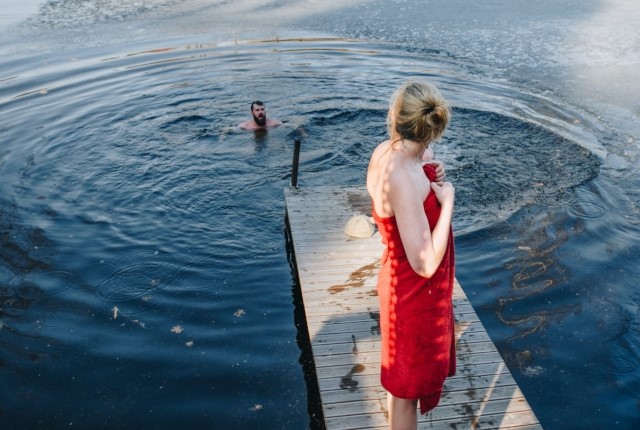
Body + Mind is reader-supported. We may earn an affiliate commission when you buy through some of the links on our site.
Women of childbearing age who regularly swim laps at the YMCA might know their menstrual periods seemingly cease when they hit the water. But is this actually what happens? Why do periods stop in the water, seemingly? Does a woman’s uterus somehow know when she goes swimming, and call a halt to business as usual down there?
Not precisely. While little if any blood gets released from the body when a woman swims, taking a dip doesn’t hit a mysterious off switch in the female body. It may seem like Aunt Flo has vacated the premises, but anyone who’s ever ruined her favorite beach cover-up knows her cycle doesn’t screech to a sudden halt while aqua-bound.
The answer to the question, “Why do periods stop in the water?” is, in short, they don’t. However, several factors do contribute to the myth of Mother Nature pulling the plug on periods while swimming. The simplest explanation for the phenomenon? Gravity.
Believe it or not, women who look to the sky explain why menstruation ceases down below. Many female astronauts suppress their periods by using certain birth control medications at launch time, but not all do. Studies by NASA to determine the dangers of menstruation in space demonstrate how changes in outside pressure influence what goes on inside the female reproductive system.
When a woman’s body is horizontal, as it is when she is practicing almost any type of swimming stroke, the power of gravity cannot pull blood and tissue down and out of the body. With nowhere to go, the blood remains trapped in the woman’s vagina until she returns to standing upright. Believing in the myth that menstruation stops when a woman does the butterfly stroke has caused many women considerable embarrassment — not to mention ruined swimsuits.
Women who attempt to regulate their menstrual periods here on Earth due to pain have long felt better after a swim. Menstrual cramps can stem from uterine contractions, but also occur when larger clumps of tissue try to fit through the cervical opening. Being submerged in water reduces your weight by up to 90 percent, which means swimming removes pressure on many parts of your body, including the cervix. Thus, cramping is often assuaged! Additionally, the exercise from swimming causes women to release endorphins, feel-good body chemicals that boost moods naturally.
But what about women who enter the water to enjoy a soak in a hot tub, for example? Why do periods stop in the water for them? Once again, the answer is a matter of simple physics.
While submerged in water, even though it doesn’t flood into the vaginal opening, the pressure keeps blood from seeping out. The “Cardinal” would need to do some serious bench presses before growing strong enough for the tiny amount of menstrual blood a woman expels to spring a leak. When she emerges from the water, this pressure dissipates, which gets things flowing again.
What about women who find they suffer less intense PMS and menstrual side effects during the summer months? During the summer, women absorb more sunlight, increasing their bodies’ production of vitamin D. Additionally, the extra activity most participate in when the days grow longer helps decrease some of the mood changes associated with monthly hormonal shifts.
Many women believe they need to refrain from swimming in the ocean while menstruating due to fears of provoking a shark attack. While a shark can smell blood from quite a distance, reports of such attacks show no support for the idea menstruating women get attacked more often. While most diving experts agree the risk does not increase, disproving this theory proves difficult — how many women would willingly sign up to take their chances in an experiment to disprove this threat?
Trying to fit a pad in a skimpy bikini is a task akin to David trying to slay Goliath without his trusty slingshot. As a result, many women choose to use tampons or menstrual cups while on their periods, at least when they’re hitting the beach. As tampon and cup use can lead to dangerous toxic shock syndrome, women benefit from changing their tampon or cup immediately after swimming to prevent bacteria from the surrounding water getting trapped inside.
During menstruation, women lose relatively little blood, but they do lose significant amounts of fluid nevertheless. Coupled with fun in the sun, this can lead to greater risks of dehydration than women face the rest of the month. Keeping a water bottle at the ready always makes good health sense, but it becomes even more critical to carry one with you when going down the shore before the scarlet Elvis leaves the building.
One thing women don’t have to fret about? Leaving a blood trail in the water. Since the water pressure holds the blood inside, women need not worry about leaving a crimson trail behind them like something out of a special effect in the movie “Jaws.”
The bottom line? No, periods do not stop when a woman goes swimming or takes a dip in the hot tub to ease painful cramps. And since exercise benefits even those who menstruate with barely a twinge, heading out to hit an aqua aerobics class or swim a few laps may be just what the doctor ordered for eliminating periodic discomfort.